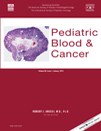18-fluorodeoxyglucose-positron emission tomography (FDG-PET) evaluation of nodular lesions in patients with neurofibromatosis type 1 and plexiform neurofibromas (PN) or malignant peripheral nerve sheath tumors (MPNST)†
Conflicts of interest: Nothing to declare.
Abstract
Background
Individuals with Neurofibromatosis type 1 (NF1) are at risk for developing malignant peripheral nerve sheath tumors (MPNST), which frequently arise in preexisting plexiform neurofibromas (PN). Magnetic resonance imaging (MRI) with volumetric analysis and 18-fluorodeoxyglucose-positron emission tomography (FDG-PET) were utilized to monitor symptomatic nodular lesions.
Procedure
Patients with NF1 and PN on a NCI natural history trial were monitored for total body tumor volume (TTV) using volumetric MRI. FDG-PET was performed in individuals with a nodular well-demarcated lesion ≥3 cm if they were growing, painful, or there was a prior history of MPNST (target lesions). Asymptomatic nodular lesions were evaluated as non-target lesions.
Results
Fifteen patients (8m, 7f) median age of 18.3 years (range, 10–45 years) had a single target and non-target (n = 46) nodular lesions identified on MRI. Target lesions arose within (n = 8) or outside (n = 3) a PN, and all but 1 had increased FDG uptake. FDG uptake was increased in non-target lesions but to a lesser degree. FDG uptake in the surrounding PN was low, similar to background activity. Pathologic evaluation performed in 11 patients demonstrated neurofibroma (n = 6), atypical neurofibroma (n = 2) and malignancy (n = 3).
Conclusions
Nodular target lesions identified on MRI in individuals with NF1 and PN demonstrate increased FDG uptake similar to MPNST, but may be benign on biopsy. Nodular target lesions may be at greater risk for malignant transformation, but their biologic and clinical behavior has not been well studied. Careful longitudinal evaluation will be required to better understand the malignant potential of these lesions. Pediatr Blood Cancer 2013; 60: 59–64. © 2012 Wiley Periodicals, Inc.




